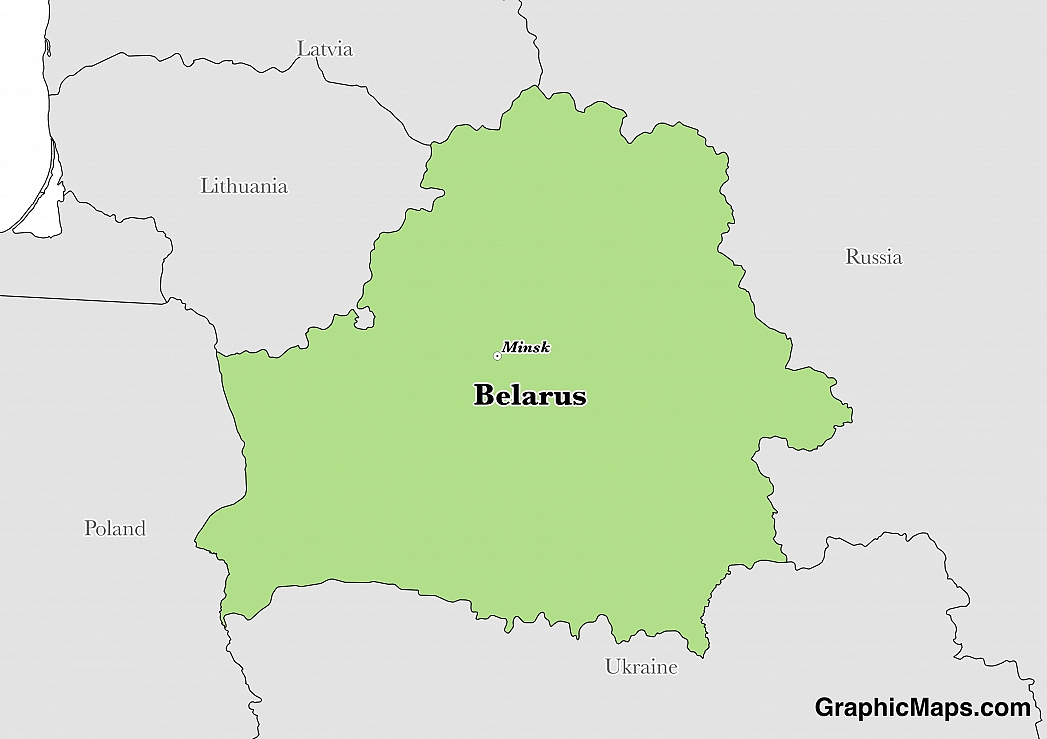Where is Belarus?
Located in Eastern Europe east of Poland, Belarus has a 3,642.00 km border with Latvia (161 km), Lithuania (640 km), Poland (418 km), Russia (1,312 km) and Ukraine (1,111 km). Its boundary is demarcated with both Latvia and Lithuania.
Minsk experiences a hemiboreal humid continental climate classified as “Dfb” under the Koppen classification. Its weather is unstable and is prone to sudden changes due to the influence of the moist air of the Atlantic and the dry air flowing from the Eurasian landmass. The city experiences a severe winter and has no dry season. The summers are warm. The mean annual temperature is about 5.8 degrees Celsius.
Read more on Belarus's CapitalBelarus is a European country covering 207,600.00 km2 of which 2.26% is water and 202,900.00 km2 is land. This makes it the 84th largest country in the world and slightly less than twice the size of Kentucky; slightly smaller than Kansas. Its geographic coordinates are 53 00 N, 28 00 E and Minsk is the capital city.
The country's name is a compoud of the Belarusian words "bel", meaning "white", and "Rus", which is an Old East Slavic ethnic designation.
Its ISO code is BY.
Geography
Belarus has a mean elevation of 160 m above sea level.
It experiences cold winters and cool, wet summers. Its terrain is generally flat and filled with marshland.
Population
Belarus has a population of 9,570,376 making it the 92nd largest in the world. The population of the country is fairly distributed.
Russian is the official language; Belarussian is also spoken. The majority ethnic group reported is Belarusian followed by Russian. The population is mostly Orthodox Christian, with some Catholic and irreligious groups.
Belarusian and Russian are the two official languages of Belarus. Belarussian consist of 45 to 54 phonemes: 39 to 48 consonants and six vowels. Russian consists of five vowels and 21 consonants. The Russian alphabet consists of 33 letters while Belarusian has 32 letters. Belarusian is spoken by 11.9% of the population although 53.2% consider it their mother tongue. Russian is spoken by 72% of the population although only 41.5% consider it their mother tongue. Polish, Eastern Yiddish, and Ukrainian and Trasianka are minority languages.
Read more on Belarus's LanguagesThe dialing code for the country is 375.
Government
Belarus is an independent country. It gained independence when the Soviet Union dissolved in 1991. Its constitution was last ratified in 1994.
Belarus is a presidential republic where the president is the head of state while the prime minister heads the government. The National Assembly of the Republic of Belarus is a bicameral parliament that consists of the Council of the Republic and the House of Representatives. The parliament building is located at Independence Square in the capital city of Minsk. National elections in Belarus elect the president and the legislature. The House of Representatives has 110 members elected by single-seat constituencies to serve for a four-year term.
Read more on Belarus's GovernmentEconomy
Factoring in Purchasing Power Parity, Belarus's GDP is $166,000,000,000.00 (USD) with $17,500.00 (USD) per capita. This makes it the 71st largest economy and its citizens the 90th richest in the world. The currency of Belarus is the Ruble (BYR).
Its major export partners are Germany, France, and the Netherlands. Its main exports are machinery and equipment, mineral products, and chemicals. Its major import partners are Russia, China, and Germany. Its major imports include mineral products, machinery, and chemicals.
Flag
The Belarusian flag consists of two horizontal stripes of blue on top and red at the bottom, and a vertical red-ornament-pattern stripe on the staff end. It was adopted in 2012 although it was passed as the design of the national flag during the 2005 referendum. The design replaced the white-red-white flag that was adopted in 1918 by the Belarusian People's Republic. The green color represents the future of Belarus. It is associated with hope and the forests and fields of the country. The red color symbolizes the struggle for independence and the blood that was shed by those who fought for independence. The vertical decorative stripe symbolizes the country's rich cultural heritage, unity and the spirit of continuity.
Read more on Belarus's FlagThis page was last modified on January 17th, 2018
More on Graphicmaps

Published on 2019-11-06
What is a Trade Embargo?

Published on 2019-11-04
Which Two Countries Used to Have the Same Flag?

Published on 2019-09-16
What Is the Only Two-Sided State Flag?

Published on 2019-09-16
Which Country Flag Looks Like the Texas Flag?

Published on 2019-08-29
Flags That Resemble the US Flag

Published on 2019-08-20
